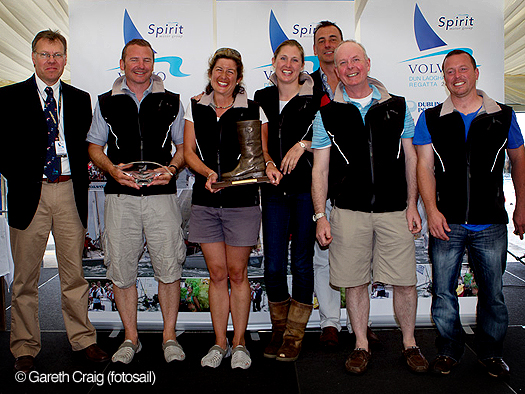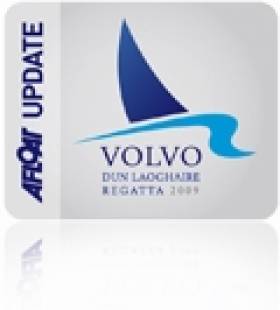Displaying items by tag: Tonner
Another Quarter Tonner Comes up for Sale
#BOATS FOR SALE – A Quarter Ton yacht for sale at €8,000 is 'a great club racer' that 'normally cleans up in Class 3', that's according to a new advertisment on Afloat's Boats for Sale site this morning. The yacht Manzanita has been 'reduced to sell' by owner George Kenefick, the recently crowned All Ireland Sailing Champion.
Earlier this month a similar yacht, a Bolero 26, Bandit, sold quickly prompting seller Ian Travers to write and record his thanks for the interest generated from the advert on the Afloat boats for sale site (cost €10).
Quarter Ton racing looks like a popular style of sailing for the current times. A leading example, Supernova took top prize at this year's Volvo Dun Laoghaire Regatta and both the 2011 ICRA Nationals and the Sovereign's Cup championed the small boat cause.
The latest addition to the boats for sale site is 'a steal for the price' says Kenefick who makes the 1977 vintage craft sound like an ideal winter project for a Dublin Bay or Cork Harbour campaign in 2012.
The boat had a new 'Formula' rig in 2006 and new mainsheet track in 2008 with new Harken cam cleats.
The boat was resprayed in 2005 but now needs a few touch ups.
All sails are from McWilliam Sailmakers. A mast head kite and a small kite are inlcuded.
The boat is lying in Hamble UK on a Trailer but you can see photos of her on the full advert here.
Sailing to Success on Supernova
She maybe old but she's still a fast one. Don't let the fact that a 33-year old local yacht took top prize from a combined fleet of 420 competitors at Ireland's biggest sailing regatta, the Volvo regatta in Dun Laoghaire yesterday.
The three sailors involved in the campaign, skipper Ken Lawless, Sybil McCormack and Pat Shannon have invested in a three year campaign to get the quarter tonner Supernova up to speed and it was only after a season of modifications last year that they found the real go button on the Dubois Starflash design.


In fact, Supernova won from O'Driscoll by only the narrowest of margins and only after the third tie-break was applied to the arch rivals.
Both boats had equal points plus three wins and two second places apiece. Both had also discarded a second place and so the class, and the 2011 title, was decided on countback and who won the last race.
In a season of successes for the vintage Dubois Starflash design Dun Laoghaire sailor Lawless and his partners Sybil McCormack and Pat Shannon have already won class honours in June’s Lambay race. The quarter tonner has taken overall honours too in Dublin Bay Sailing Club's first series this season.
Part of the reason for the success has been a winter of overhauls to the 1978 design including extra downwind sail area and improved stability with the relocation of its floorboards. The improvements brought about better performances downwind, especially in light airs.

The vintage boat from the old IOR handicap days is in fact a carbon copy of the famous 1979 Admiral's Cupper two tonner Police Car, a boat that has held huge appeal for Lawless.
"We were second to Hard on Port at this regatta two years ago when they won boat of the week so there was intense rivalry today but we knew we could do it!" Lawless said last night.
Racing Round up: Dun Laoghaire Regatta, ISAF Youths, Optimists, Paralympic, RORC, WIORA, Quarter Ton, Kiteboarding.
In offshore news, the Transatlantic Race 2011 Nears a Finish, and RORC yachts that headed West did best in the St Malo from Cowes race. Ireland's entry in the Tall Ships race, Celtic Mist, is safely in Scotland. WIORA starts this week in Clifden, thirty boats are expected.
Two top Cork performers are in Cowes for this week's Quarter Ton Cup.
In other boating news, rower Siobhan McCrohan won bronze at the World Rowing Champs in Lucerne, Kiteboarding debuted in Dun Laoghaire. There were Medals for Irish Kayakers at Athens Special Olympics.
And finally after a Elaine 'Shooter' Alexander is set for hero's welcome this week as she becomes the first woman from Northern Ireland to circumnavigate the island of Ireland.
All on our home page this morning, thanks for your interest in Irish Sailing and Boating.
Second Irish Quarter Tonner Heads for Cowes
Following Monday's report on the Irish championship winning yacht Tiger (Neil Kenefick) sailing in the Quarter Ton Cup in Cowes next week a second Royal Cork Yacht, Eamonn Rohan's Quarter tonner 'Anchor Challenge' is also heading to the Solent. Her crew is made up of Eamonn, Nigel Young, Sam Hunt, Ian Travers and Mick Liddy. This boat won the event in 2009 so she has form. Watch this space!

Anchor Challenge is heading for Cowes. Photo: Bob Bateman. Scroll down for more.

































































